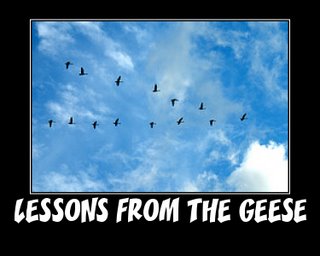
The geese who inhabit the wildlife preserve where we walk each day have hunkered down away from humans, preparing I think for their migration. Occasional small formations of geese fly to and from the preserve these days, but they don’t come looking for food from us as they did in spring. I wonder if you see them, too, heading south for the winter flying along in "V" formation? Do you know what science has discovered as to why they fly that way?
FACT 1 - As each Goose flaps its wings it creates uplift for the birds that follow. By flying in a V formation, the whole flock adds 71 per cent greater flying range than if each bird flew alone.
FACT 2 - When a Goose falls out of formation, it suddenly feels the drag and resistance of flying alone. It quickly moves back into formation to take advantage of the lifting power of the bird immediately in front of it.
FACT 3 - When the lead Goose tires, it rotates back into the formation and another Goose flies to the point position.
FACT 4 - The Geese flying in formation honk to encourage those up front to keep up their speed.
FACT 5 - When a Goose gets sick, wounded or shot down, two Geese drop out of formation and follow it down to help and protect it. They stay with it until it dies or is able to fly again. Then, they launch out with another formation or catch up with the flock.
Are there lessons we can learn from a gaggle of geese? What do you think?
I think that Samus is absolutely right when he suggests that we could help each other when someone falls behind and that rotating leadership can help any group! I'm adding what many see as lessons from the geese; they include what Samus has mentioned.
FACT 1 - As each Goose flaps its wings it creates uplift for the birds that follow. By flying in a V formation, the whole flock adds 71 per cent greater flying range than if each bird flew alone.
LESSON - People who share a common direction and sense of community can get where they are going more quickly and easily because they are traveling on the thrust of one another.
FACT 2 - When a Goose falls out of formation, it suddenly feels the drag and resistance of flying alone. It quickly moves back into formation to take advantage of the lifting power of the bird immediately in front of it.
LESSON - If we are as smart as a Goose we stay in formation with those headed where we want to go. We are willing to accept their help and give our help to others.
FACT 3 - When the lead Goose tires, it rotates back into the formation and another Goose flies to the point position.
LESSON - It pays to take turns doing the hard tasks and sharing leadership. As with Geese, people are interdependent on each other's skills, capabilities and unique arrangements of gifts, talents or resources.
FACT 4 - The Geese flying in formation honk to encourage those up front to keep up their speed.
LESSON - We need to make sure our honking is encouraging. In groups where there is encouragement, the production is much greater. The power of encouragement (to stand by one's heart or core values and encourage the heart and core of other) is the quality of honking we seek.
FACT 5 - When a Goose gets sick, wounded or shot down, two Geese drop out of formation and follow it down to help and protect it. They stay with it until it dies or is able to fly again. Then, they launch out with another formation or catch up with the flock.
LESSON - If we have the wisdom of Geese, we will stand by each other in difficult times as well as when we are strong.
Is there value in remembering the lessons from the geese?

Yes, we could learn from gaggles of geese because we could relate. When we're in a group working together there is a leader, and when that leader gets tired another person could take place. There is a pattern or way of how we are working together. When someone is falling behind then others could help so that they could get back on track. Well, to me thats what i see when i read this post. Interesting.
ReplyDelete